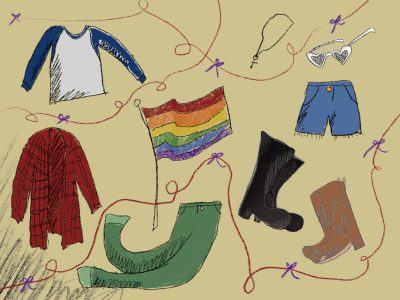“I can’t wear this shirt anymore,” my female friend said, showing me some of her new purchases.
“But it’s so cute,” I replied, to which she agreed.
“Then why don’t you want to wear it out?”

“People won’t see that I’m gay.”
I was so disappointed that a shirt she loved just days before was suddenly unwearable to her because of how it would appear to the public eye. And I expressed this aloud to her — encouraging her to wear the shirt regardless of what it looks like to others.
But at the same time, I related to her deeply. The moment represented a small sliver of so many conversations of the sort I’ve had with other queer friends and, quite often, myself.
Many queer people like “femmes” — feminine-presenting women — tend to struggle with the idea of others being able to see their queerness. Media has often shown society that the way to show that you’re a queer woman (whether that be lesbian, bisexual, pansexual or any other label), is to dress more masculine, carry yourself a certain way or overtly wear rainbow colors. Because of this, people often have a narrow perspective of how we look and dress.
That leaves a lot of feminine-presenting queer women with the problem of feeling as though they look heterosexual. This can create a feeling of disconnection from fellow queer communities, and can pose trouble with attracting other women because one might assume heterosexuality merely on appearance.
Identity markers are often expressed through style — a community with a common trait often shares fashion items or elements. This applies to any group of people, not just queer communities, and can help aid in unity and belonging. To the public, it creates a sense of visibility and affirmation in terms of that common trait.
Although these effects are absolutely positive, it’s also very possible that dressing in a non-typical way for a community can hinder validation and create a dissonance between inner self and outward presentation of identity.
If you don’t dress to society’s standards, or even as the LGBTQ+ community’s standards dictate, it may be hard to convey that queerness. This can then create a lack of societal understanding, and therefore insecurity, in the expression of that identity.
It’s an unfortunate fact of life that who we are and who others view us as often differ, and being queer often adds layers to that. Society’s narrow views of queerness have expanded in recent years, but stereotypes based on appearance very much still exist.
And it’s a shame that misrepresentation and stereotypes make us feel a dissonance between our authentic self expression and the identities we carry.
So the truth is, unless you’re basing your identity on stereotypes, there is no way to “look gay.” We are who are, and our self expression is a product of our own choices.
Changing your outward natural self-expression just to attract friends or romantic interests is futile and relentless, because at the end of the day, you’re not drawing people toward an authentic version of yourself.
Dressing in a way that feels right to you, and not the way society perceives the social groups you belong to, is paramount.
If how you present yourself to the world feels forced, it’s never worth “looking” the way the public expects you to. There are other ways to connect with the identities you belong to, and true friends and allies will not exclude you from a community just because you don’t fit a mold.





















































































































